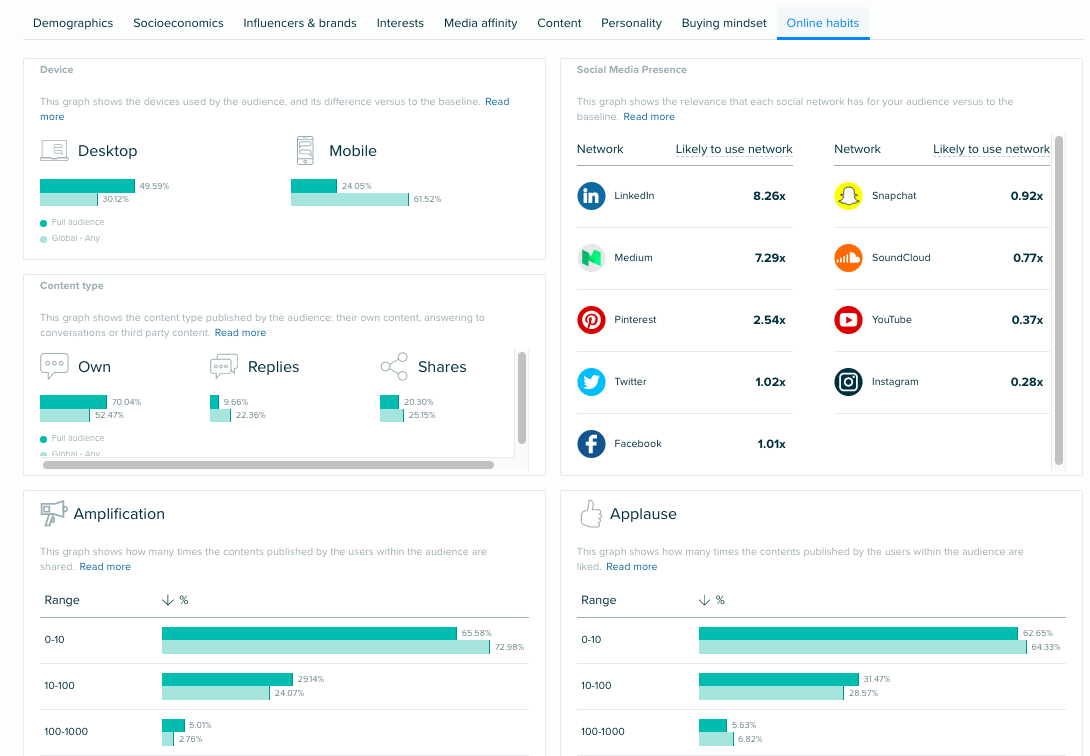This tab provides insights into the audience's online habits, including device type used, social media channel relevance, content distribution and activity, compared to the selected baseline.
- Device – device types used by the audience.
-
- The device chart in the online habits tab showcases the audience preferences in terms of the device type used: mobile vs desktop when compared to the baseline.
- When looking at active audience members, we track the clients they use to post on Twitter, applying a classification based on the type of device these clients run on (desktop or mobile clients; see below examples), and the distribution of their known activity across these clients.
- Mobile client examples:
- Twitter for Android
- Twitter for iOS
- Twitter for iPad
-
- Desktop client examples:
- Twitter native client for Mac
- Hootsuite native Mac app
- Desktop client examples:
- Social Media Relevance – the relevance that each social network has for your audience compared to the baseline.
- Based on engagements shared across Twitter from other networks
- Networks included: Discord, Facebook, Instagram, LinkedIn, Medium, Pinterest, Reddit, SinaWeibo, Snapchat, SoundCloud, Spotify, TikTok, Telegram, Twitch, Twitter, WeChat, Weibo, WhatsApp, YouTube.
- The graph shows the relevance that each social network has for your audience versus the baseline.
- Interpretation
- Interpret the graph comparing the data vs the baseline to identify what is most relevant to your audience. In this case, the weight of the social network is NOT measured within the audience you are analyzing.
- Example of correct interpretation: "Snapchat is 2 times more relevant (2x) to the segment / audience compared to the baseline (UK population).
- Example of incorrect interpretation: "There are 4 times more people who use Twitter" or "People use Facebook more than Twitter"
- Interpret the graph comparing the data vs the baseline to identify what is most relevant to your audience. In this case, the weight of the social network is NOT measured within the audience you are analyzing.
- Example of use
- The relevance of social networks helps corroborate or dispute the presence in a network or the investment in marketing, for tactical or strategic reasons. In this case, it is also necessary to combine the data with public information on the use of social networks for each country: https://indd.adobe.com/view/15280b35-8827-433f-9e5a-07f1ec8c23f2?allowFullscreen=true
-
- How is it calculated
- Our algorithms are constantly evolving. Generally, through machine learning, Audiense infers the social media presence of the users within the audience according to the interactions (tweets, follows, likes, clicks, etc.), the information in the profiles of the users (name, profile picture, bio), other public information (demographic census) or combinations of these.
- How is it calculated
- Content type – content type published by the audience: their own content, answering conversations or third party content.
- Amplification – how many times the contents published by the users within the audience are shared.
- Applause – how many times the contents published by the users within the audience are liked.
- Active days – days the users within the audience are more active on social networks.
- Active hours – time frames of when the users within the audience are more active on social networks.
